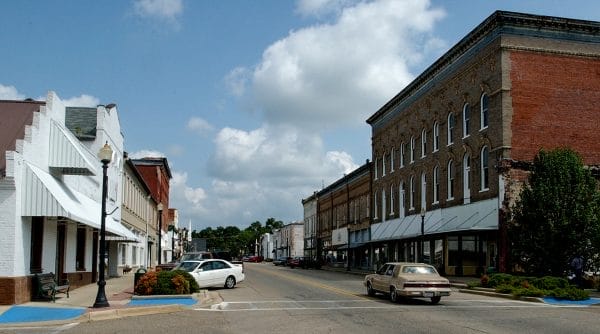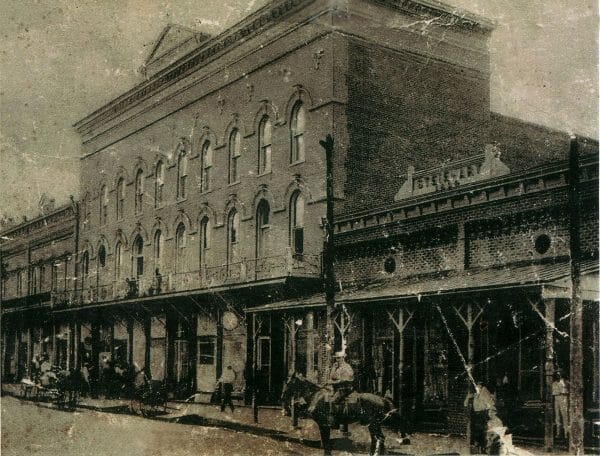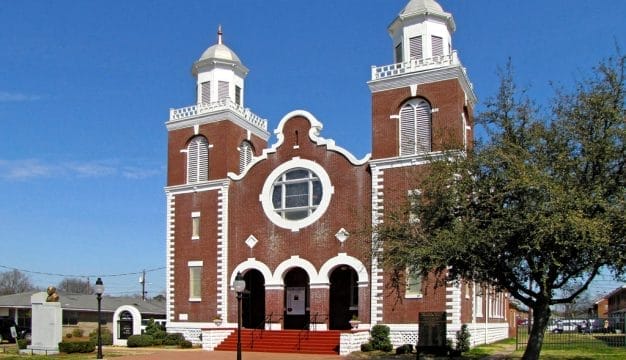Greensboro
 Greensboro
Greensboro is the county seat of Hale County and is located in west-central Alabama in the Black Belt region. The town was once a center of the plantation agriculture system and was the birthplace of what is now Birmingham-Southern College. Greensboro gained national attention as the center of Walker Evans’s and James Agee’s exploration of the effects of the Great Depression on rural Americans in the 1930s. It is home to a number of historic homes, including Magnolia Grove, and is a center of Alabama’s catfish farming industry. Greensboro has a mayor-council form of government.
Greensboro
Greensboro is the county seat of Hale County and is located in west-central Alabama in the Black Belt region. The town was once a center of the plantation agriculture system and was the birthplace of what is now Birmingham-Southern College. Greensboro gained national attention as the center of Walker Evans’s and James Agee’s exploration of the effects of the Great Depression on rural Americans in the 1930s. It is home to a number of historic homes, including Magnolia Grove, and is a center of Alabama’s catfish farming industry. Greensboro has a mayor-council form of government.
History
 Noel-Ramsey Home
Before white settlement, the land that now includes Greensboro was part of the Choctaw Nation. The Choctaw lands were made available for purchase after being ceded to the U.S. government in the 1816 Treaty of Fort St. Stephens. The first homesteaders of the area that would become Greensboro were the Russell family, and the community was first known as Russell Settlement. The following year, the town was renamed Troy. In 1819, the town relocated nearby to its present site and was renamed New Troy. In 1823, the town was renamed Greensboro and was officially incorporated on December 24. In 1856, the Methodist Church established Southern University (now Birmingham-Southern College in Birmingham) in Greensboro. In 1867, Hale County was created from territory carved from several other existing counties, and Greensboro was named as its county seat. Town leaders purchased Salem Church from the Alabama Baptist Convention and moved the county government and court offices into the building. The economy of the town centered around agriculture, particularly cotton production. By the turn of the century, the economy had diversified to include mercantile enterprises, milling and ginning facilities, and warehouses.
Noel-Ramsey Home
Before white settlement, the land that now includes Greensboro was part of the Choctaw Nation. The Choctaw lands were made available for purchase after being ceded to the U.S. government in the 1816 Treaty of Fort St. Stephens. The first homesteaders of the area that would become Greensboro were the Russell family, and the community was first known as Russell Settlement. The following year, the town was renamed Troy. In 1819, the town relocated nearby to its present site and was renamed New Troy. In 1823, the town was renamed Greensboro and was officially incorporated on December 24. In 1856, the Methodist Church established Southern University (now Birmingham-Southern College in Birmingham) in Greensboro. In 1867, Hale County was created from territory carved from several other existing counties, and Greensboro was named as its county seat. Town leaders purchased Salem Church from the Alabama Baptist Convention and moved the county government and court offices into the building. The economy of the town centered around agriculture, particularly cotton production. By the turn of the century, the economy had diversified to include mercantile enterprises, milling and ginning facilities, and warehouses.
 Greensboro Opera House
Greensboro’s economy centered on cotton until the Civil War, after which it shifted to livestock and other cash crops. The Great Depression hit Greensboro’s economy very hard, as it did in most of the rural South. In an attempt to capture the effects of the Depression, playwright James Agee and photographer Walker Evans used Greensboro as a home base as they documented the lives of three sharecropper families in the surrounding county. By the mid-twentieth century, timber companies had established large pine plantations in the county, but Greensboro’s overall economy began to decline.
Greensboro Opera House
Greensboro’s economy centered on cotton until the Civil War, after which it shifted to livestock and other cash crops. The Great Depression hit Greensboro’s economy very hard, as it did in most of the rural South. In an attempt to capture the effects of the Depression, playwright James Agee and photographer Walker Evans used Greensboro as a home base as they documented the lives of three sharecropper families in the surrounding county. By the mid-twentieth century, timber companies had established large pine plantations in the county, but Greensboro’s overall economy began to decline.
On April 27, 2011, a massive storm, causing numerous powerful tornadoes, struck the southeastern United States. More than 250 people were killed in Alabama, including two people in Greensboro.
Demographics
According to 2020 Census estimates, Greensboro recorded a population of 2,956. Of that number, 77.1 percent identified themselves as black, 22.2 percent as white, 0.2 percent as Hispanic or Latino, and 0.2 percent as two or more races. The city’s median household income was $22,132, and per capita income was $16,573.
Employment
According to 2020 Census estimates, the workforce in Greensboro was divided among the following industrial categories:
- Educational services, and health care and social assistance (32.3 percent)
- Arts, entertainment, recreation, and accommodation and food services (16.8 percent)
- Retail trade (15.5 percent)
- Manufacturing (10.8 percent)
- Professional, scientific, management, and administrative and waste management services (7.0 percent)
- Public administration (5.1 percent)
- Transportation and warehousing and utilities (3.9 percent)
- Other services, except public administration (3.5 percent)
- Construction (3.2 percent)
- Agriculture, forestry, fishing and hunting, and extractive (1.0 percent)
- Wholesale trade (0.7 percent)
- Finance, insurance, and real estate, rental, and leasing (0.3 percent)
Education
Schools in Greensboro are part of the Hale County Public School System. Greensboro has two elementary schools, one middle school, and three high schools.
Transportation
Greensboro Municipal Airport serves general aviation. The town lies on State Highway 69, which runs north-south through the town, and State Highway 14, which runs east-west through the town.
Events and Places of Interest
 Safe House Museum Restored Cladding
The Greensboro Historic District, which encompasses the entire downtown area, is listed on the National Register of Historic Places and features nearly 150 nineteenth-century structures, including the Greensboro Opera House and the Noel-Ramsey House (ca. 1819), constructed by French settlers from the Vine and Olive Colony in nearby Demopolis. Magnolia Grove (1840) is the birthplace of Richmond Pearson Hobson, who later gained fame for his exploits in the Spanish-American War. Visitors to Greensboro can learn more about civil rights and slavery at the Safe House Black History Museum, which houses a collection of media and artifacts.
Safe House Museum Restored Cladding
The Greensboro Historic District, which encompasses the entire downtown area, is listed on the National Register of Historic Places and features nearly 150 nineteenth-century structures, including the Greensboro Opera House and the Noel-Ramsey House (ca. 1819), constructed by French settlers from the Vine and Olive Colony in nearby Demopolis. Magnolia Grove (1840) is the birthplace of Richmond Pearson Hobson, who later gained fame for his exploits in the Spanish-American War. Visitors to Greensboro can learn more about civil rights and slavery at the Safe House Black History Museum, which houses a collection of media and artifacts.



